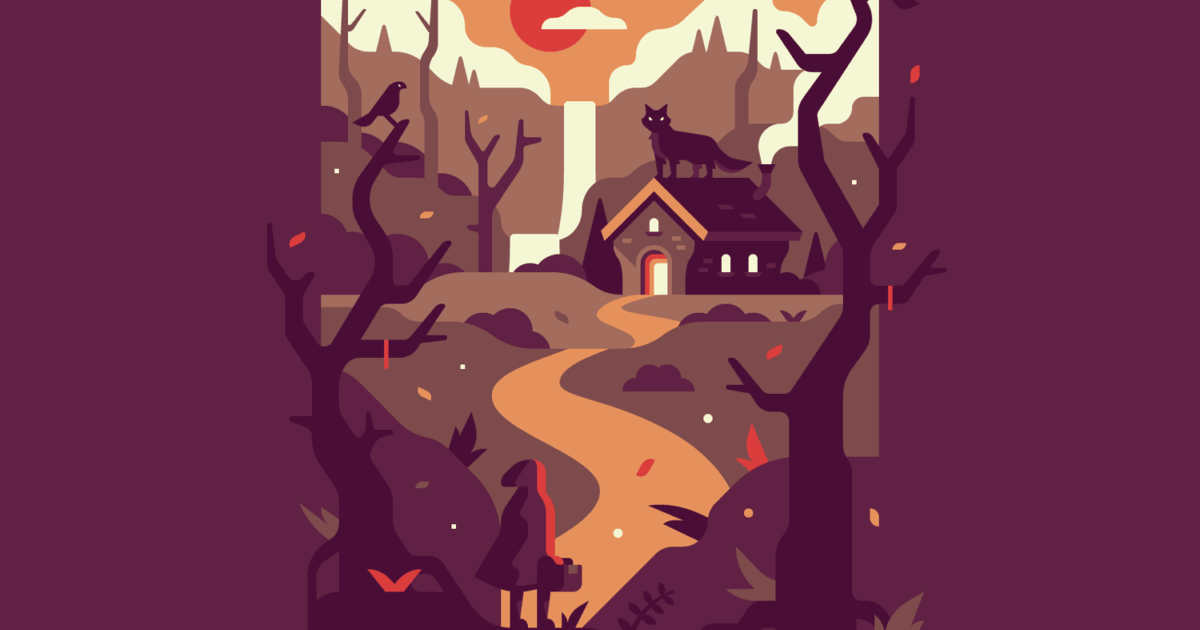

Little Red Riding Hood says that the wolf has big legs. She then sees the wolf but believes him to be her naked grandmother. He tells Little Red Riding Hood to put the cake and butter to one side, take off her clothes and get into bed with him. When Little Red Riding Hood comes inside the house, the wolf hides under the bedclothes. The voice sounds somewhat strange to Little Red Riding Hood but she assumes that is because her grandmother has a cold. Attempting to disguise his voice, the wolf tells her that the door is not locked. Little Red Riding Hood knocks on the door. 1867 illustration by the French artist Gustave Doré. The wolf and Little Red Riding Hood in bed. As soon as he is inside the house, the wolf, who has not eaten for three days, falls on the old woman and eats her. The old woman says that the door is not locked. Disguising his voice, the wolf says that he is Little Red Riding Hood. The sick old woman asks who is there because she cannot get out of bed. The wolf arrives at Little Red Riding Hood's grandmother's house and knocks at the door. Little Red Riding Hood also takes some time to get to her grandmother's house because she stops to gather nuts, pick flowers and chase butterflies. The wolf knows that the path that he has chosen for himself is the shorter one. He says that he will take one path and tells Little Red Riding Hood to take a different one. The wolf says that he will go to Little Red Riding Hood's grandmother's house too. It is the first one in the village and it is just beyond a mill. She points out her grandmother's house to him. The wolf asks Little Red Riding Hood where her grandmother lives. Not knowing that it is dangerous to talk to wolves, Little Red Riding Hood tells him that she is taking a cake and some butter to her sick grandmother. The wolf asks the girl where she is going. He would like to eat her but is unable to do so at that moment because there are some woodcutters nearby. In the forest, a wolf comes up to Little Red Riding Hood. In order to get there, Little Red Riding Hood has to pass through a forest. Little Red Riding Hood's grandmother lives in another village. She gives the cake and a pot of butter to the girl and tells her to take them to her grandmother, who has been ill. Little Red Riding Hood's mother makes a cake. It looks so good on the girl that she becomes known as Little Red Riding Hood. Her grandmother gives her a red cape with a hood. Her mother and grandmother are especially fond of her. There is a little village girl who is loved by everyone who sees her. 1896 illustration by the British artist and writer Walter Crane. The wolf approaches Little Red Riding Hood. 4.1 Sound files of public domain audiobboks.There have been numerous adaptations of "Little Red Riding Hood" to other media and the story is often referenced in popular culture. Little Red Riding Hood talks to the wolf, believing him to be her grandmother. By the time that Little Red Riding Hood arrives at her grandmother's house, the wolf has already eaten or otherwise disposed of the girl's grandmother and is lying in the old woman's bed. He asks the girl where she is going and Little Red Riding Hood tells him. The wolf wants to eat Little Red Riding Hood but does not do so immediately. Little Red Riding Hood goes to visit her sick grandmother. The story's title character and protagonist is a little girl who gets her name because of the red hooded cape that she usually wears. The tale as many people in the English-speaking world know it today more closely resembles the Brothers Grimm version than the Charles Perrault one. A different version of the story is included in Kinder und Hausmäechen ( Children's and Household Tales), the 1812 anthology of German folktales compiled by the Brothers Grimm.

Although the story of "Little Red Riding Hood" probably originated many centuries ago, no text for it exists that it is older than the version written by the French author Charles Perrault and included in his 1697 anthology Histoires ou Contes du temps passé ( Fairy Tales from Past Times with Morals or Mother Goose Tales). Similar stories also exist in African and Asian folklore. "Little Red Riding Hood" (French: "Le Petit Chaperon rouge" German: "Rotkäppchen') is a European fairy tale. Little Red Riding Hood as depicted in an 1859 painting by Luis Ammy Blanc.


 0 kommentar(er)
0 kommentar(er)
